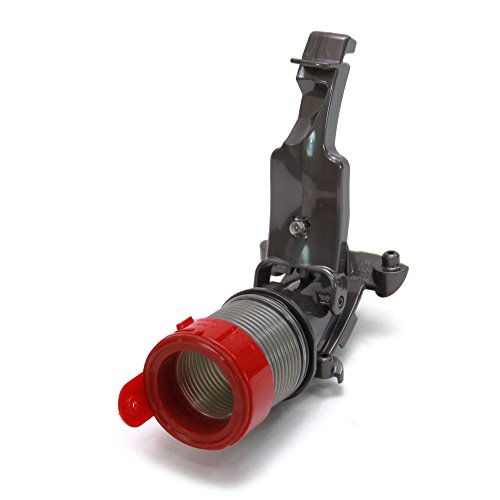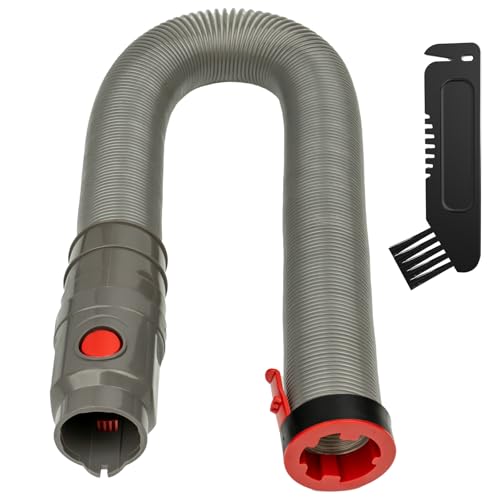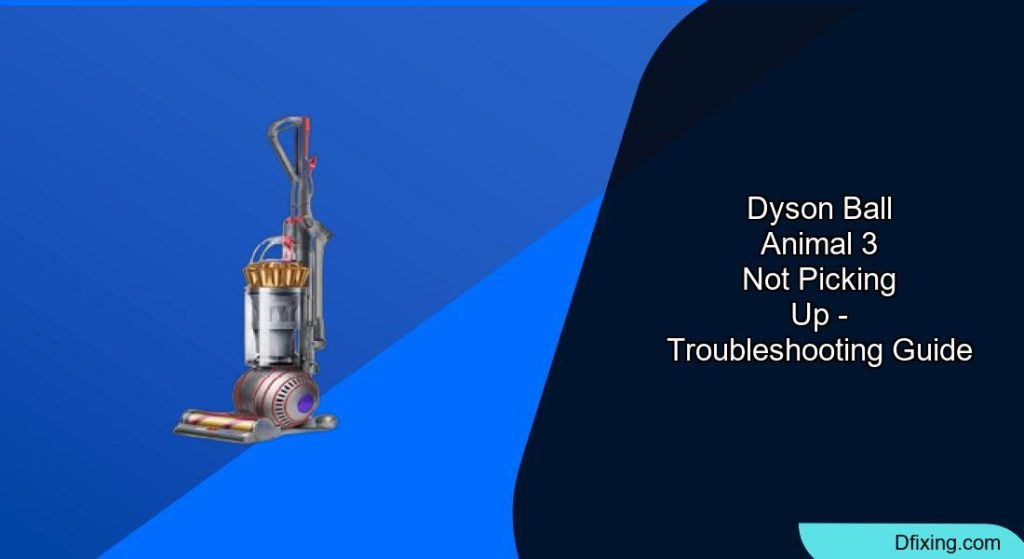The Dyson Ball Animal 3 is renowned for its powerful suction capabilities, making it a favorite among pet owners. However, like any vacuum cleaner, it can sometimes experience suction problems that hamper its performance. When your once-powerful Dyson starts to lose its suction strength, it can be frustrating, especially when dealing with pet hair and debris.
Affiliate disclosure: As an Amazon associate, We'll earn a commission for every successful order through our affiliate links in the article. However, you won’t be charged anything for this.
In this comprehensive guide, we’ll explore the most common causes of suction loss in the Dyson Ball Animal 3 and provide detailed, step-by-step solutions to restore your vacuum’s performance. From simple maintenance tasks to more complex troubleshooting, we’ll cover everything you need to know to get your Dyson working like new again. Whether you’re dealing with a completely blocked vacuum or just noticing reduced cleaning power, these proven solutions will help you diagnose and fix the problem efficiently.
Common Causes of Suction Loss in Dyson Ball Animal 3
When your Dyson Ball Animal 3 isn’t performing at its best, several factors could be responsible. Identifying the root cause is the first step toward resolving the issue. Here are the most frequent culprits behind suction problems:
Overfilled Dust Bin
One of the most common and easily overlooked causes of suction loss is a full dust bin. Even if the bin doesn’t appear completely full, accumulated debris can restrict airflow.
How to fix it:
1. Locate the dust bin release button on your Dyson Ball Animal 3
2. Press the button and carefully remove the bin
3. Hold the bin over a trash can and press the release mechanism to empty contents
4. For a thorough cleaning, remove the entire bin assembly
5. Rinse the bin under cold water (avoid using detergents)
6. Allow the bin to dry completely before reattaching
7. Ensure the bin clicks securely back into place
Regular emptying of the dust bin—ideally after each use—prevents debris buildup and maintains optimal suction power.
Clogged Hose or Wand
Blockages in the hose or wand significantly impact your vacuum’s suction capability. Large debris, pet hair, or small objects can become lodged in these pathways.
How to fix it:
1. Disconnect the hose from both ends of the vacuum
2. Visually inspect the hose interior using a flashlight
3. For visible blockages, use a broom handle or similar long object to gently push through the obstruction
4. For stubborn blockages, use scissors to carefully cut away entangled items
5. Clean the interior with a soft-bristled brush
6. Check the wand for kinks or blockages and clear as needed
7. Reattach the hose and test suction
If you find that your current hose is damaged beyond repair, a replacement will restore proper airflow.

Official Dyson replacement for Animal 3 models

High-quality non-OEM with quick install

Upgraded design for DC40/DC41 models
Dirty or Clogged Filters
The Dyson Ball Animal 3 relies on its filtration system to maintain suction. Dirty filters restrict airflow and reduce cleaning performance.
How to fix it:
1. Locate both filters on your Dyson Ball Animal 3:
– Pre-motor filter (typically near the dust bin)
– Post-motor filter (usually on the ball itself)
2. Remove both filters from the vacuum
3. Rinse each filter under cold running water
4. Continue rinsing until water runs clear
5. Gently squeeze out excess water (do not wring or twist)
6. Allow filters to air dry completely for at least 24 hours
7. Reinstall dry filters securely in their original positions
Dyson recommends washing filters monthly for optimal performance. Never operate your vacuum with wet filters or without filters installed.
If your filters are damaged or you want to have a spare set, consider purchasing replacement filters.

Premium HEPA filters with 0.3 micron filtration for Dyson Ball Animal 3 models

High-efficiency HEPA filters capturing 0.3 micron particles for Ball Animal 3

Washable HEPA filters with 0.3 micron filtration for Ball Animal 3 vacuums
Worn or Damaged Brush Bar
The brush bar (or beater bar) plays a crucial role in the vacuum’s effectiveness, especially on carpets. When it’s damaged or clogged, suction performance suffers.
How to fix it:
1. Turn off and unplug your Dyson Ball Animal 3
2. Flip the vacuum over to access the brush bar
3. Look for the release mechanism (usually a coin-slot screw)
4. Remove the brush bar according to your model’s instructions
5. Cut away hair, string, or fibers wrapped around the bar
6. Remove remaining debris with a soft brush
7. Check for missing bristles or other damage
8. If severely damaged, purchase a replacement brush bar
9. Reinstall the brush bar, ensuring it spins freely
10. Secure all fasteners before using the vacuum
Internal Valve Issues
The Dyson Ball Animal 3 uses internal valves to direct suction between the wand and cleaner head. When these valves malfunction, suction can be compromised.
How to fix it:
1. Lay the vacuum on its front
2. Remove the cleaner head
3. Turn the machine over so the bin faces upward
4. Place your hand over the opening
5. Turn on the machine to test suction
6. Locate the changeover valve (where the hose connects to the machine)
7. Ensure the valve moves freely and isn’t stuck
8. Clean any debris around the valve
9. If the valve is damaged, consult Dyson support for replacement options
Clogged Change Valve
A particularly common issue with the Dyson Animal series is a jammed change valve within the hose assembly. This valve redirects suction between the wand and roller brush.
How to fix it:
1. Remove the secondary filter on the left side of the vacuum
2. Access the hose interior
3. Locate the change valve mechanism
4. Use gloves and a flashlight to inspect for blockages
5. Remove any pet hair, debris, or foreign objects (socks are common culprits)
6. Use needle-nose pliers for stubborn debris if necessary
7. Avoid forcing the valve mechanism
8. Reassemble and test suction in different positions
Advanced Troubleshooting Techniques
If the basic solutions don’t resolve your suction issues, these more advanced troubleshooting steps may help identify and fix the problem.
Checking the Cyclone Assembly
The cyclone assembly is the heart of your Dyson’s suction system. When clogged, it significantly impacts performance.
How to fix it:
1. Remove the dust bin from your Dyson Ball Animal 3
2. Inspect the cyclone assembly for visible debris
3. Tap the cyclone unit gently to dislodge hidden dust
4. Use a soft brush to clean between cyclone components
5. For stubborn debris, use compressed air (at low pressure)
6. Avoid using water on the cyclone assembly
7. Ensure all cyclone pathways are clear before reassembling
Testing Suction at Different Points
This diagnostic approach helps pinpoint exactly where suction is being lost in your vacuum system.
How to perform the test:
1. Start by testing suction directly at the machine (where the hose connects)
2. If suction is strong at this point but weak at the cleaning head, the issue is in the pathway between these points
3. Test the hose by detaching it and checking suction at both ends
4. Test the wand separately
5. Check the base unit connection points
6. Methodically work through each component until you identify where suction drops
Addressing Motor or Seal Issues
Sometimes, suction problems stem from the motor itself or damaged seals throughout the vacuum.
Signs of motor issues:
– Unusual noises during operation
– Vacuum running hot
– Intermittent power or suction
– Complete power failure
How to check seals:
1. Inspect all connection points for intact rubber seals
2. Look for cracks, tears, or missing seals
3. Check the dust bin seal carefully
4. Examine the hose connection points
5. Inspect the filter housing seals
For confirmed motor issues, contact Dyson support as this typically requires professional repair.
Model-Specific Troubleshooting
DC50 Weak Floor Suction Fix
If your DC50 model has weak suction specifically on floors despite no visible clogs, the changeover hose may be misaligned or damaged.
Replacement procedure:
1. Gather required tools: T15 and T8 Torx screwdrivers
2. Remove the four screws securing the filter cover
– Note: Two screws may fall into the motor compartment; use a magnet to retrieve if needed
3. Remove the two T8 Torx screws holding the hose housing
4. Disengage the spring from the bottom
5. Remove the old hose assembly
6. Align the new hose’s short end with the top of the housing
7. Ensure the gasket is properly seated
8. Reassemble the unit
9. Test by switching between floor and upright positions
DC41 Beater Brush Reset
For DC41 models with non-functioning beater brushes, try this reset procedure:
- Locate the on/off button for the brush bar
- Extend the beater bar fully
- Hold the power button while toggling the on/off switch five times
- Test the brush bar operation
- If unsuccessful, disassemble and clean the beater brush thoroughly
- Clean or replace the side-mounted filters
- Ensure the beater bar is fully extended during any reset attempts
Preventive Maintenance Tips
Preventing suction problems is easier than fixing them. Implement these maintenance practices to keep your Dyson Ball Animal 3 performing optimally:
Regular Cleaning Schedule
Daily/After Each Use:
- Empty the dust bin
- Check for and remove obvious clogs
- Clear hair from the brush bar
Weekly:
- Inspect the hose and wand for blockages
- Check the brush bar for wrapped hair or fibers
- Wipe down the exterior of the vacuum
Monthly:
- Wash both filters
- Clean the dust bin thoroughly
- Inspect all seals for damage
- Check for unusual noises during operation
Proper Usage Practices
- Avoid vacuuming wet surfaces or liquids
- Don’t pick up fine particles like construction dust without appropriate filters
- Use the correct attachment for each surface type
- Adjust brush settings based on floor type
- Avoid overfilling the dust bin (empty at 2/3 capacity)
- Use slow, methodical passes for better debris pickup
Frequently Asked Questions (FAQ)
Why does my Dyson Ball Animal 3 have strong suction at the hose but weak suction at the cleaner head?
This typically indicates a blockage in the pathway between the hose and cleaner head, or an issue with the changeover valve. Check for obstructions in the wand and base connections. Also, ensure the changeover valve is functioning properly by testing suction in different vacuum positions. If the valve is stuck, follow the cleaning procedures outlined in the clogged change valve section above.
How often should I clean the filters on my Dyson Ball Animal 3?
Dyson recommends washing both filters monthly under cold water. However, if you have pets or vacuum frequently, you may need to clean them more often. Signs that filters need cleaning include reduced suction, unusual odors, or visible dirt on the filters. Always allow filters to dry completely (at least 24 hours) before reinstalling them.
My Dyson Ball Animal 3 makes a high-pitched noise and has poor suction. What could be wrong?
A high-pitched noise combined with poor suction often indicates an airflow restriction. First, check for blockages in the hose, wand, and brush bar. If no blockages are found, inspect the cyclone assembly for built-up debris. The noise could also indicate that the motor is straining due to restricted airflow. Clean all filters and ensure all pathways are clear. If the noise persists, there may be an issue with the motor that requires professional attention.
How do I know if my Dyson’s motor needs to be replaced?
Signs of motor problems include unusual or loud noises, burning smells, the vacuum running extremely hot, intermittent power, or complete failure to turn on. If you’ve ruled out blockages, filter issues, and other common problems, and the vacuum still performs poorly, the motor may need professional assessment. Contact Dyson customer support for guidance, as motor replacement typically requires specialized service.
Can I use my Dyson Ball Animal 3 without filters while they’re drying?
No, you should never operate your Dyson without all filters properly installed. Doing so can damage the motor and void your warranty. The filters protect the motor from dust and debris. If your filters are being washed, wait until they are completely dry before using the vacuum again. Consider purchasing a second set of filters to use while your primary set is drying.
Conclusion
Suction problems with your Dyson Ball Animal 3 can usually be resolved through systematic troubleshooting and regular maintenance. Most issues stem from blockages, filter problems, or mechanical obstructions that are fixable at home with simple tools and techniques.
By following the comprehensive troubleshooting steps outlined in this guide, you can diagnose and resolve most suction-related issues. Remember that preventive maintenance—including regular emptying of the dust bin, filter cleaning, and brush bar inspection—is the best way to maintain your vacuum’s performance over time.
If you’ve tried all the suggested solutions and still experience suction problems, don’t hesitate to contact Dyson’s customer support. They can provide model-specific guidance and determine if professional service is needed. With proper care and maintenance, your Dyson Ball Animal 3 should provide powerful suction and effective cleaning for many years to come.







